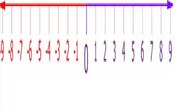
Integers are whole numbers used in counting, addition, subtraction, multiplication and division. The idea of integers first originated in ancient Babylon and Egypt. A number line contains both positive and negative integers with positive integers represented by numbers to the right of zero and negative integers represented by the numbers to the left of zero. Visualizing a number line helps when performing mathematical calculations with integers.
Positive Integers
Zero is an integer which denotes absence of anything. The positive integers are drawn to the right of the number zero on the number line and ascend in order for example 1, 2, 3, 4 and 5. The space between each integer on a number line is equal so statements about size are relevant for example 2 is twice as large as 1, 10 is twice as large as 5 and 100 is twice as large as 50.
Negative Integers
Each positive integer on a number line has a negative pair, for example 2 is paired with (-2), 5 with (-5) and 50 with (-50). Pairs represent an equal distance away from the zero on a number line, for example 50 is 50 units to the right of zero while (-50) is 50 units to the left of zero. Spaces between negative integers are also equal, so (-10) is twice as large as (-5).
Adding Integers
There are several rules to remember when adding integers. When adding two positive integers move to the right on the number line. For example in 5 + 3 = 8 start at the number 5 and move 3 spaces to the right, ending at the number 8. When adding a negative integer to a positive integer move to the left on the number line. For example in 3 + (-5) = (-2) start at the number 3 and move five spaces to the left, ending at (-2). When adding a positive integer to a negative integer move to the right on the number line. For example in (-3) + 5 = 2. Start at (-3) and move five spaces to the right, ending at 2. When adding two negative integers move to the left on the number line. For example in (-3) + (-2) = (-5) start at (-3) and move two spaces to the left on the number line, ending at (-5).
Subtracting Integers
There are several rules to remember when subtracting integers. When subtracting two positive integers move to the left on the number line. For example in 5 - 3 = 2 start at five and move three spaces to the left, ending at 2. When subtracting a negative integer from a positive integer move to the right on a number line. For example in 5 - (-3) = 8, start at 5 and move three spaces to the right, ending at 8. Subtracting a negative is the same thing as correcting an error -- If you were balancing your checkbook and you had $8 in it but accidentally took $3 out you would incorrectly say you had $5 in the bank. Realizing your mistake you put the (-$3) back into the bank, realizing you actually have $8. When subtracting a positive integer from a negative integer move to the left on the number line. For example in (-5) - 3 = (-8) start at (-5) and move three spaces to the left, ending at (-8). This is like owing someone $5 and accruing another dept of $3 – you now owe $8. When subtracting two negative integers move to the right on the number line. For example in (-5) - (-2) = (-3) start at (-5) and move two spaces to the right on the number line, ending at (-3). Think of this as owing someone $5 and then paying off $2 of your debt – you now only owe $3.
Multiplying Integers
Multiplication is just a short-hand form of addition. For example 2 x 3 really means add the number two together three times so 2+2+2 = 6 and 2 x 3 = 6. It’s best to memorize multiplication tables to save time. There are four basic rules to remember. Multiplying two positive integers results in a positive integer. Multiplying a positive integer by a negative integer results in a negative integer. Multiplying a negative integer by a positive integer results in a negative integer. Multiplying two negative integers together results in a positive integer.
Dividing Integers
All integers, whether positive or negative can be divided. Dividing is seeing how many times one integer will go into another evenly and what is left over. The number 6 divided by 3 is really asking the question, “How many times does 3 go into 6?” Because 3 + 3 = 6, mathematicians say that 3 goes into 6 two times. The four basic rules to remember for division are identical to those of multiplication. Dividing two positive integers results in a positive integer. Dividing a positive integer by a negative integer results in a negative integer. Dividing a negative integer by a positive integer results in a negative integer. Dividing a negative integers by a negative integer results in a positive integer.
References
About the Author
Brenda Scottsdale is a licensed psychologist, a six sigma master black belt and a certified aerobics instructor. She has been writing professionally for more than 15 years in scientific journals, including the "Journal of Criminal Justice and Behavior" and various websites.
Photo Credits
Photos.com/Photos.com/Getty Images
